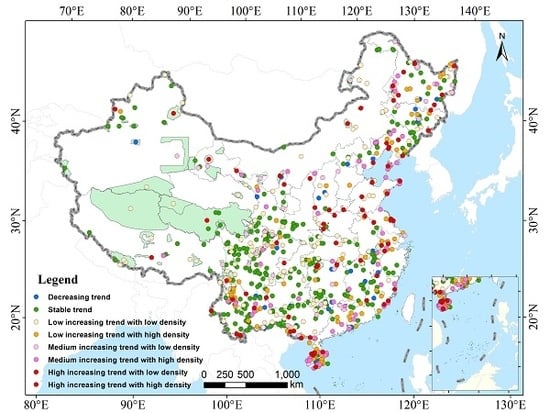Characterizing Light Pollution Trends across Protected Areas in China Using Nighttime Light Remote Sensing Data
Abstract
:1. Introduction
2. Materials and Methods
2.1. Study Area
2.2. Data Sources
2.2.1. Nighttime Light Imagery
2.2.2. Protected Areas Dataset
2.3. Methods
2.3.1. Nighttime Light Index
2.3.2. Spatial Pattern Analysis
2.3.3. Spatial Trend Analysis
2.3.4. Division of Light Pollution Change Levels in PAs
3. Results
3.1. The Trends and Patterns of Light Pollution in PAs from 1992 to 2012
3.2. Classification of Light Pollution Change Levels in PAs
3.3. Cause Analysis of Light Pollution Change in PAs
4. Discussion
5. Conclusions
- (1)
- The TNL and NLM indexes were employed to analyze the trend in light pollution in the PAs from 1992 to 2012 across China. Compared with 1992, the percentage of dark PAs decreased by more than 20% by 2012. From 1992 to 2012, most PAs (57.30%) experienced an increase in light pollution, and these PAs were mainly located in eastern and central China and a small part of western China. According to the results of the hot spot analysis, the distribution of changes in TNL and NLM both had obvious spatial agglomeration characteristics.
- (2)
- According to the TNL index and the NLM index, the PAs impacted by light pollution were divided into eight categories. Most PAs showed a stable trend (41%), but approximately 10% showed a high increasing trend; however, of those with a high increasing trend, those that had a high increasing trend with low density accounted for a small percentage, i.e., only 1%, and were mainly located in large-area PAs in western China.
- (3)
- High-resolution satellite images and statistical data were selected to analyze the causes of light pollution changes in PAs. The results showed that decreasing distance to an urban area, mineral exploitation and tourism development may increase light pollution in PAs. In contrast, the migration of residents away from an area may be one explanation for the decrease in light pollution.
Author Contributions
Funding
Conflicts of Interest
References
- Betts, M.G.; Wolf, C.; Ripple, W.J.; Phalan, B.; Millers, K.A.; Duarte, A.; Butchart, S.H.M.; Levi, T. Global forest loss disproportionately erodes biodiversity in intact landscapes. Nature 2017, 547, 441–444. [Google Scholar] [CrossRef] [PubMed]
- Van Dover, C.L.; Ardron, J.A.; Escobar, E.; Gianni, M.; Gjerde, K.M.; Jaeckel, A.; Jones, D.O.B.; Levin, L.A.; Niner, H.J.; Pendleton, L.; et al. Biodiversity loss from deep-sea mining. Nat. Geosci. 2017, 10, 464–465. [Google Scholar] [CrossRef] [Green Version]
- Venter, O.; Fuller, R.A.; Segan, D.B.; Carwardine, J.; Brooks, T.; Butchart, S.H.M.; Di Marco, M.; Iwamura, T.; Joseph, L.; O’Grady, D.; et al. Targeting global protected area expansion for imperiled biodiversity. PLoS. Biol. 2014, 12, e1001891. [Google Scholar] [CrossRef] [PubMed]
- Butchart, S.H.M.; Scharlemann, J.P.W.; Evans, M.I.; Quader, S.; Arico, S.; Arinaitwe, J.; Balman, M.; Bennun, L.A.; Bertzky, B.; Besancon, C.; et al. Protecting important sites for biodiversity contributes to meeting global conservation targets. PLoS ONE 2012, 7, e32529. [Google Scholar] [CrossRef] [PubMed]
- Correia, R.A.; Malhado, A.C.M.; Lins, L.; Gamarra, N.C.; Bonfim, W.A.G.; Valencia-Aguilar, A.; Bragagnolo, C.; Jepson, P.; Ladle, R.J. The scientific value of amazonian protected areas. Biodivers. Conserv. 2016, 25, 1503–1513. [Google Scholar] [CrossRef]
- Cetas, E.R.; Yasue, M. A systematic review of motivational values and conservation success in and around protected areas. Conserv. Biol. 2017, 31, 203–212. [Google Scholar] [CrossRef] [PubMed]
- Vassallo, P.; Paoli, C.; Buonocore, E.; Franzese, P.P.; Russo, G.F.; Povero, P. Assessing the value of natural capital in marine protected areas: A biophysical and trophodynamic environmental accounting model. Ecol. Model. 2017, 355, 12–17. [Google Scholar] [CrossRef]
- Protected Planet Report 2014. Available online: http://wdpa.s3.amazonaws.com/WPC2014/protected_planet_report.pdf (accessed on 29 August 2017).
- Kobayashi, H.; Watando, H.; Kakimoto, M. A global extent site-level analysis of land cover and protected area overlap with mining activities as an indicator of biodiversity pressure. J. Clean. Prod. 2014, 84, 459–468. [Google Scholar] [CrossRef]
- Mutanga, C.N.; Vengesayi, S.; Muboko, N.; Gandiwa, E. Towards harmonious conservation relationships: A framework for understanding protected area staff-local community relationships in developing countries. J. Nat. Conserv. 2015, 25, 8–16. [Google Scholar] [CrossRef]
- Bruner, A.G.; Gullison, R.E.; Balmford, A. Financial costs and shortfalls of managing and expanding protected-area systems in developing countries. Bioscience 2004, 54, 1119–1126. [Google Scholar] [CrossRef]
- De Sherbinin, A. Is poverty more acute near parks? An assessment of infant mortality rates around protected areas in developing countries. Oryx 2008, 42, 26–35. [Google Scholar] [CrossRef]
- Tang, L.N.; Shao, G.F.; Piao, Z.J.; Dai, L.M.; Jenkins, M.A.; Wang, S.X.; Wu, G.; Wu, J.G.; Zhao, J.Z. Forest degradation deepens around and within protected areas in east Asia. Biol. Conserv. 2010, 143, 1295–1298. [Google Scholar] [CrossRef]
- Waite, T.A.; Corey, S.J.; Campbell, L.G.; Chhangani, A.K.; Rice, J.; Robbins, P. Satellite sleuthing: Does remotely sensed land-cover change signal ecological degradation in a protected area? Divers. Distrib. 2009, 15, 299–309. [Google Scholar] [CrossRef]
- Craigie, I.D.; Baillie, J.E.M.; Balmford, A.; Carbone, C.; Collen, B.; Green, R.E.; Hutton, J.M. Large mammal population declines in Africa’s protected areas. Biol. Conserv. 2010, 143, 2221–2228. [Google Scholar] [CrossRef]
- Laurance, W.F.; Useche, D.C.; Rendeiro, J.; Kalka, M.; Bradshaw, C.J.A.; Sloan, S.P.; Laurance, S.G.; Campbell, M.; Abernethy, K.; Alvarez, P.; et al. Averting biodiversity collapse in tropical forest protected areas. Nature 2012, 489, 290–294. [Google Scholar] [CrossRef] [PubMed] [Green Version]
- Geldmann, J.; Joppa, L.N.; Burgess, N.D. Mapping change in human pressure globally on land and within protected areas. Conserv. Biol. 2014, 28, 1604–1616. [Google Scholar] [CrossRef] [PubMed]
- Davies, T.W.; Duffy, J.P.; Bennie, J.; Gaston, K.J. Stemming the tide of light pollution encroaching into marine protected areas. Conserv. Lett. 2016, 9, 164–171. [Google Scholar] [CrossRef] [Green Version]
- Duffy, J.P.; Bennie, J.; Duran, A.P.; Gaston, K.J. Mammalian ranges are experiencing erosion of natural darkness. Sci. Rep. 2015, 5, 12042. [Google Scholar] [CrossRef] [PubMed] [Green Version]
- Rodriguez, A.; Rodriguez, B.; Negro, J.J. GPS tracking for mapping seabird mortality induced by light pollution. Sci. Rep. 2015, 5, 10670. [Google Scholar] [CrossRef] [PubMed]
- Lyytimaki, J. Nature’s nocturnal services: Light pollution as a non-recognised challenge for ecosystem services research and management. Ecosyst. Serv. 2013, 3, E44–E48. [Google Scholar] [CrossRef]
- De Freitas, J.R.; Bennie, J.; Mantovani, W.; Gaston, K.J. Exposure of tropical ecosystems to artificial light at night: Brazil as a case study. PLoS ONE 2017, 12, e0171655. [Google Scholar] [CrossRef] [PubMed]
- Falchi, F.; Cinzano, P.; Duriscoe, D.; Kyba, C.C.M.; Elvidge, C.D.; Baugh, K.; Portnov, B.A.; Rybnikova, N.A.; Furgoni, R. The new world atlas of artificial night sky brightness. Sci. Adv. 2016, 2, e1600377. [Google Scholar] [CrossRef] [PubMed] [Green Version]
- Light Pollution. Available online: http://darksky.org/light-pollution/ (accessed on 19 May 2018).
- Bennie, J.; Duffy, J.P.; Davies, T.W.; Correa-Cano, M.E.; Gaston, K.J. Global trends in exposure to light pollution in natural terrestrial ecosystems. Remote Sens. 2015, 7, 2715–2730. [Google Scholar]
- Gaston, K.J.; Bennie, J.; Davies, T.W.; Hopkins, J. The ecological impacts of nighttime light pollution: A mechanistic appraisal. Biol. Rev. 2013, 88, 912–927. [Google Scholar] [CrossRef] [PubMed]
- Raap, T.; Pinxten, R.; Eens, M. Light pollution disrupts sleep in free-living animals. Sci. Rep. 2015, 5, 13557. [Google Scholar] [CrossRef] [PubMed] [Green Version]
- Mazor, T.; Levin, N.; Possingham, H.P.; Levy, Y.; Rocchini, D.; Richardson, A.J.; Kark, S. Can satellite-based night lights be used for conservation? The case of nesting sea turtles in the Mediterranean. Biol. Conserv. 2013, 159, 63–72. [Google Scholar] [CrossRef]
- Shi, K.F.; Chen, Y.; Yu, B.L.; Xu, T.B.; Yang, C.S.; Li, L.Y.; Huang, C.; Chen, Z.Q.; Liu, R.; Wu, J.P. Detecting spatiotemporal dynamics of global electric power consumption using DMSP-OLS nighttime stable light data. Appl. Energy 2016, 184, 450–463. [Google Scholar] [CrossRef]
- Liu, Z.F.; He, C.Y.; Zhang, Q.F.; Huang, Q.X.; Yang, Y. Extracting the dynamics of urban expansion in china using DMSP-OLS nighttime light data from 1992 to 2008. Landsc. Urban. Plan. 2012, 106, 62–72. [Google Scholar] [CrossRef]
- Jiang, W.; He, G.J.; Long, T.F.; Liu, H.C. Ongoing conflict makes Yemen dark: From the perspective of nighttime light. Remote Sens. 2017, 9, 798. [Google Scholar] [CrossRef]
- Li, X.; Chen, F.; Chen, X. Satellite-observed nighttime light variation as evidence for global armed conflicts. IEEE J. Sel. Top. Appl. Earth. Obs. Remote Sens. 2013, 6, 2302–2315. [Google Scholar]
- Aubrecht, C.; Elvidge, C.D.; Longcore, T.; Rich, C.; Safran, J.; Strong, A.E.; Eakin, C.M.; Baugh, K.E.; Tuttle, B.T.; Howard, A.T.; et al. A global inventory of coral reef stressors based on satellite observed nighttime lights. Geocarto Int. 2008, 23, 467–479. [Google Scholar] [CrossRef]
- Bennie, J.; Davies, T.W.; Duffy, J.P.; Inger, R.; Gaston, K.J. Contrasting trends in light pollution across europe based on satellite observed night time lights. Sci. Rep. 2014, 4, 3789. [Google Scholar] [CrossRef] [PubMed] [Green Version]
- Jiang, W.; He, G.J.; Long, T.F.; Wang, C.; Ni, Y.; Ma, R.Q. Assessing light pollution in china based on nighttime light imagery. Remote Sens. 2017, 9, 135. [Google Scholar] [CrossRef]
- Cinzano, P.; Falchi, F.; Elvidge, C.D. The first world atlas of the artificial night sky brightness. Mon. Not. R. Astron. Soc. 2001, 328, 689–707. [Google Scholar] [CrossRef]
- Han, P.; Huang, J.; Li, R.; Wang, L.; Hu, Y.; Wang, J.; Huang, W. Monitoring trends in light pollution in china based on nighttime satellite imagery. Remote Sens. 2014, 6, 5541–5558. [Google Scholar] [CrossRef]
- Butt, M.J. Estimation of light pollution using satellite remote sensing and geographic information system techniques. GISci. Remote Sens. 2012, 49, 609–621. [Google Scholar] [CrossRef]
- Gaston, K.J.; Duffy, J.P.; Bennie, J. Quantifying the erosion of natural darkness in the global protected area system. Conserv. Biol. 2015, 29, 1132–1141. [Google Scholar] [CrossRef] [PubMed]
- Guetté, A.; Godet, L.; Juigner, M.; Robin, M. Worldwide increase in artificial light at night around protected areas and within biodiversity hotspots. Biol. Conserv. 2018, 223, 97–103. [Google Scholar] [CrossRef]
- Zhang, L.; Luo, Z.H.; Mallon, D.; Li, C.W.; Jiang, Z.G. Biodiversity conservation status in china’s growing protected areas. Biol. Conserv. 2017, 210, 89–100. [Google Scholar] [CrossRef]
- Shi, K.F.; Huang, C.; Chen, Y.; Li, L.Y. Remotely sensed nighttime lights reveal increasing human activities in protected areas of china mainland. Remote Sens. Lett. 2018, 9, 468–477. [Google Scholar] [CrossRef]
- Jiang, W.; He, G.; Ni, Y. Assessment of light pollution impact on protected areas in China. Int. Arch. Photogramm. Remote Sens. Spat. Inf. Sci. 2017, 42, 1307–1312. [Google Scholar] [CrossRef]
- Xu, W.H.; Xiao, Y.; Zhang, J.J.; Yang, W.; Zhang, L.; Hull, V.; Wang, Z.; Zheng, H.; Liu, J.G.; Polasky, S.; et al. Strengthening protected areas for biodiversity and ecosystem services in china. Proc. Natl. Acad. Sci. USA 2017, 114, 1601–1606. [Google Scholar] [CrossRef] [PubMed]
- Protected Area Profile for China from the World Database of Protected Areas. Available online: https://www.protectedplanet.net/country/CN (accessed on 29 August 2016).
- Protected Planet. Available online: https://www.protectedplanet.net/ (accessed on 19 May 2018).
- Version 4 DMSP-OLS Nighttime Lights Time Series. Available online: https://ngdc.noaa.gov/eog/dmsp/downloadV4composites.html (accessed on 16 June 2017).
- International Union for Conservation of Nature. Available online: https://www.iucn.org/ (accessed on 20 May 2018).
- UN Environment World Conservation Monitoring Centre. Available online: https://www.unep-wcmc.org/ (accessed on 21 May 2018).
- 2014 United Nations List of Protected Areas. Available online: http://wdpa.s3.amazonaws.com/WPC2014/2014_UN_LIST_REPORT_EN.pdf (accessed on 29 August 2016).
- Wang, Y.H.; Deng, X.M.; Marcucci, D.J.; Le, Y.E. Sustainable development planning of protected areas near cities: Case study in china. J. Urban Plan. Dev.-ASCE 2013, 139, 133–143. [Google Scholar] [CrossRef]
- Dudley, N.; MacKinnon, K.; Stolton, S. The role of protected areas in supplying ten critical ecosystem services in drylands: A review. Biodiversity 2014, 15, 178–184. [Google Scholar] [CrossRef]
- Liu, Q.P.; Yang, Y.C.; Tian, H.Z.; Zhang, B.; Gu, L. Assessment of human impacts on vegetation in built-up areas in china based on AVHRR, MODIS and DMSP_OLS nighttime light data, 1992–2010. Chin. Geogr. Sci. 2014, 24, 231–244. [Google Scholar] [CrossRef]
- Stow, D.; Petersen, A.; Hope, A.; Engstrom, R.; Coulter, L. Greenness trends of arctic tundra vegetation in the 1990s: Comparison of two NDVI data sets from NOAA AVHRR systems. Int. J. Remote Sens. 2007, 28, 4807–4822. [Google Scholar] [CrossRef]
- Li, X.; Zhan, C.; Tao, J.; Li, L. Long-term monitoring of the impacts of disaster on human activity using dmsp/ols nighttime light data: A case study of the 2008 Wenchuan, china earthquake. Remote Sens. 2018, 10, 588. [Google Scholar] [CrossRef]
- Ecological Resettlement of Tibetan Herders in the Sanjiangyuan: A Case Study in Madoi County of Qinghai. Available online: https://case.edu/affil/tibet/tibetanNomads/documents/ecologicalresettlementfortibetanherderinthesanjiangyuan.pdf (accessed on 19 May 2018).
- China Economic and Social Development Statistics Database. Available online: http://tongji.cnki.net/kns55/index.aspx (accessed on 19 May 2018).
- Loucks, C.; Ricketts, T.H.; Naidoo, R.; Lamoreux, J.; Hoekstra, J. Explaining the global pattern of protected area coverage: Relative importance of vertebrate biodiversity, human activities and agricultural suitability. J. Biogeogr. 2008, 35, 1337–1348. [Google Scholar] [CrossRef]
- Xiang, W.L.; Tan, M.H. Changes in light pollution and the causing factors in china’s protected areas, 1992–2012. Remote Sens. 2017, 9, 15. [Google Scholar] [CrossRef]
- Cinzano, P.; Falchi, F. Quantifying light pollution. J. Quant. Spectrosc. Radiat. Transf. 2014, 139, 13–20. [Google Scholar] [CrossRef]
- Gulley, A.L.; Nassar, N.T.; Xun, S. China, the United States, and competition for resources that enable emerging technologies. Proc. Natl. Acad. Sci. USA 2018, 115, 4111–4115. [Google Scholar] [CrossRef] [PubMed] [Green Version]
- Li, C.F.; Wang, A.J.; Chen, X.J.; Chen, Q.S.; Zhang, Y.F.; Li, Y. Regional distribution and sustainable development strategy of mineral resources in china. Chin. Geogr. Sci. 2013, 23, 470–481. [Google Scholar] [CrossRef]
- Lopes, P.F.M.; Mendes, L.; Fonseca, V.; Villasante, S. Tourism as a driver of conflicts and changes in fisheries value chains in marine protected areas. J. Environ. Manag. 2017, 200, 123–134. [Google Scholar] [CrossRef] [PubMed]
- Tolvanen, A.; Kangas, K. Tourism, biodiversity and protected areas—Review from Northern Fennoscandia. J. Environ. Manag. 2016, 169, 58–66. [Google Scholar] [CrossRef] [PubMed]
- Light Pollution and Dark Sky Tourism. Available online: http://www.griotsrepublic.com/light-pollution/ (accessed on 19 May 2018).
- Bennie, J.; Davies, T.W.; Cruse, D.; Gaston, K.J. Ecological effects of artificial light at night on wild plants. J. Ecol. 2016, 104, 611–620. [Google Scholar] [CrossRef] [Green Version]
- Altermatt, F.; Ebert, D. Reduced flight-to-light behaviour of moth populations exposed to long-term urban light pollution. Biol. Lett. 2016, 12, 20160111. [Google Scholar] [CrossRef] [PubMed] [Green Version]
- Gaston, K.J.; Visser, M.E.; Hoelker, F. The biological impacts of artificial light at night: The research challenge. Philos. Trans. R. Soc. B Sci. 2015, 370. [Google Scholar] [CrossRef] [PubMed]
- Kyba, C.; Kuester, T.; Sanchez de Miguel, A.; Baugh, K.; Jechow, A.; Holker, F.; Bennie, J.; Elvidge, C.; Gaston, K.; Guanter, L.; et al. Artificially lit surface of earth at night increasing in radiance and extent. Sci. Adv. 2017, 3, e1701528. [Google Scholar] [CrossRef] [PubMed]
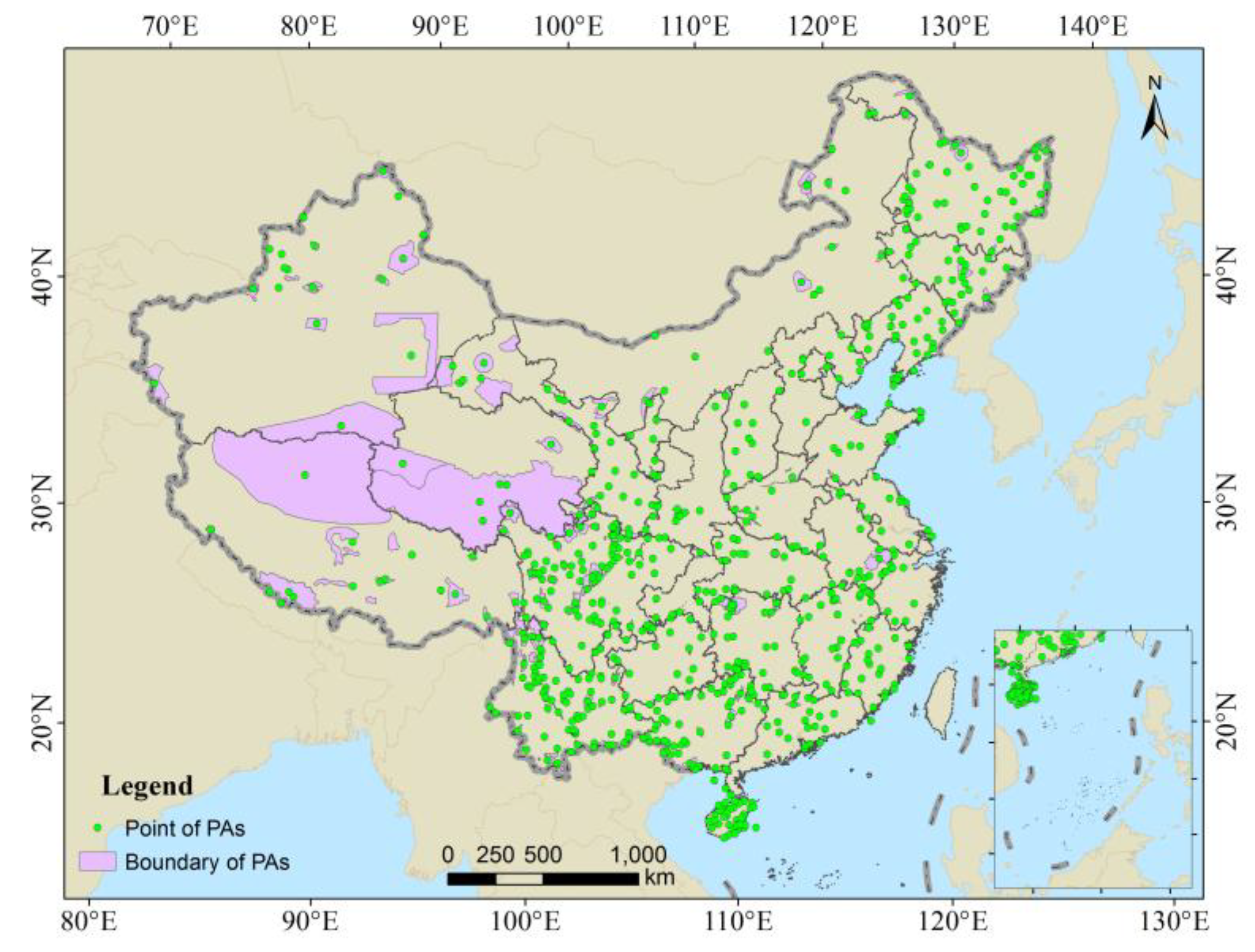
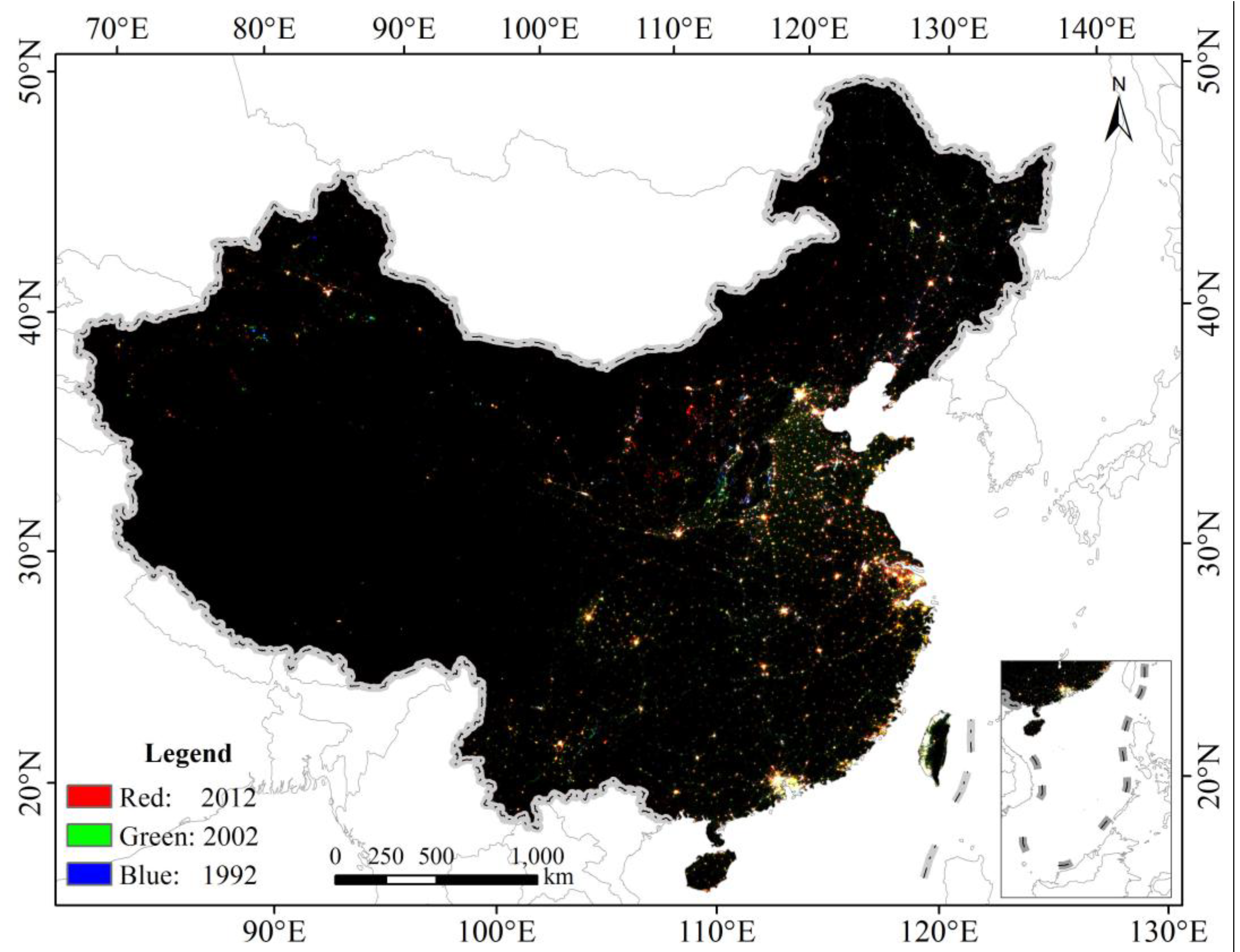
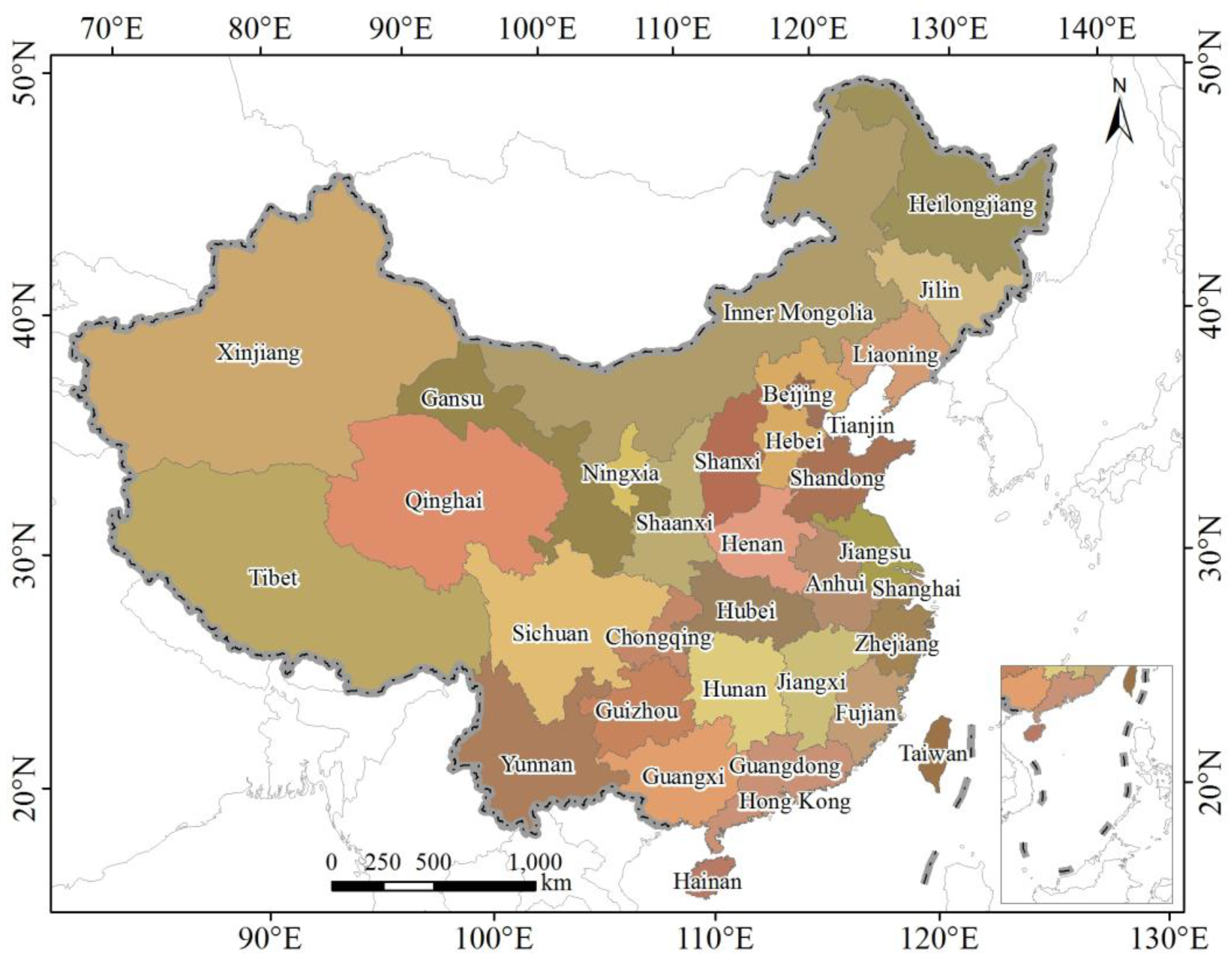
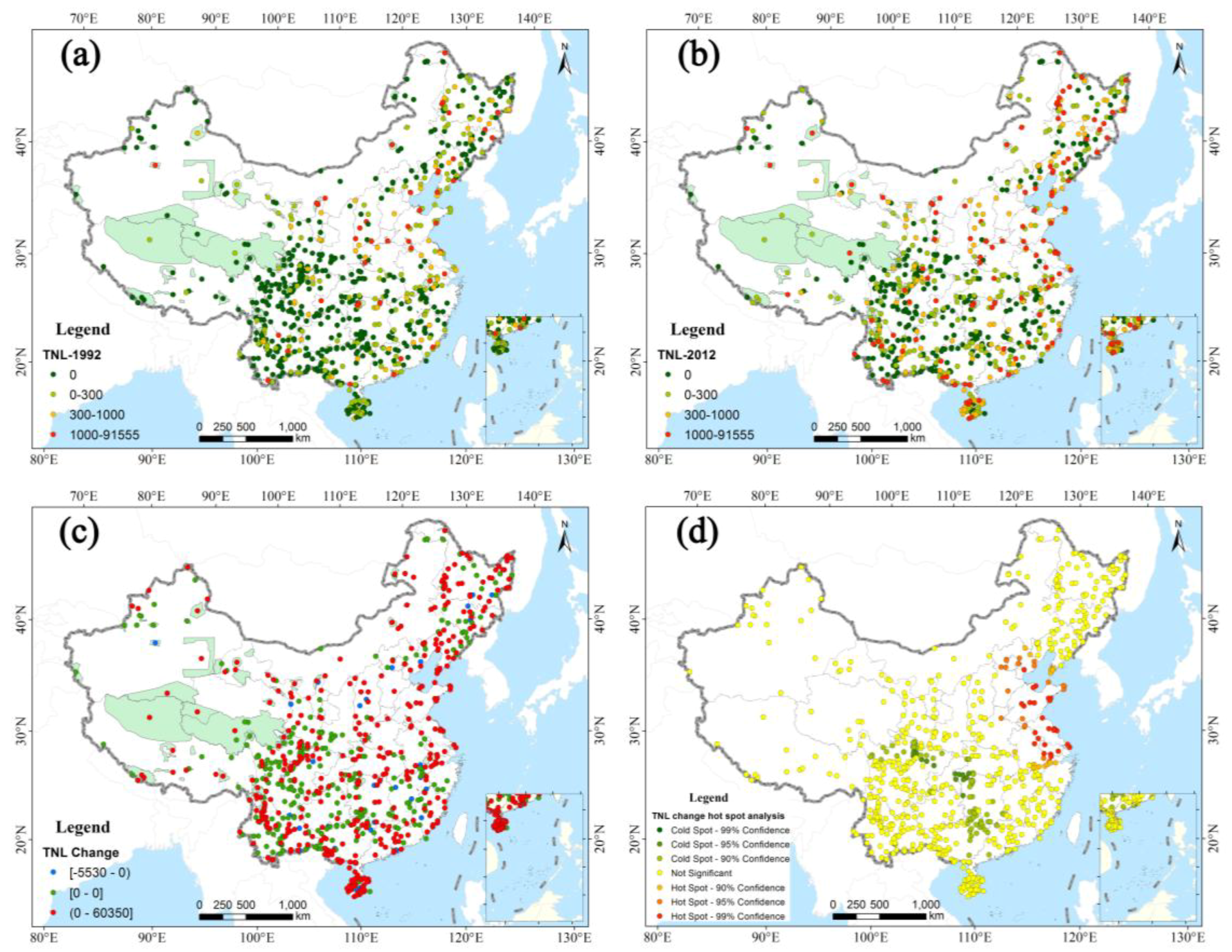
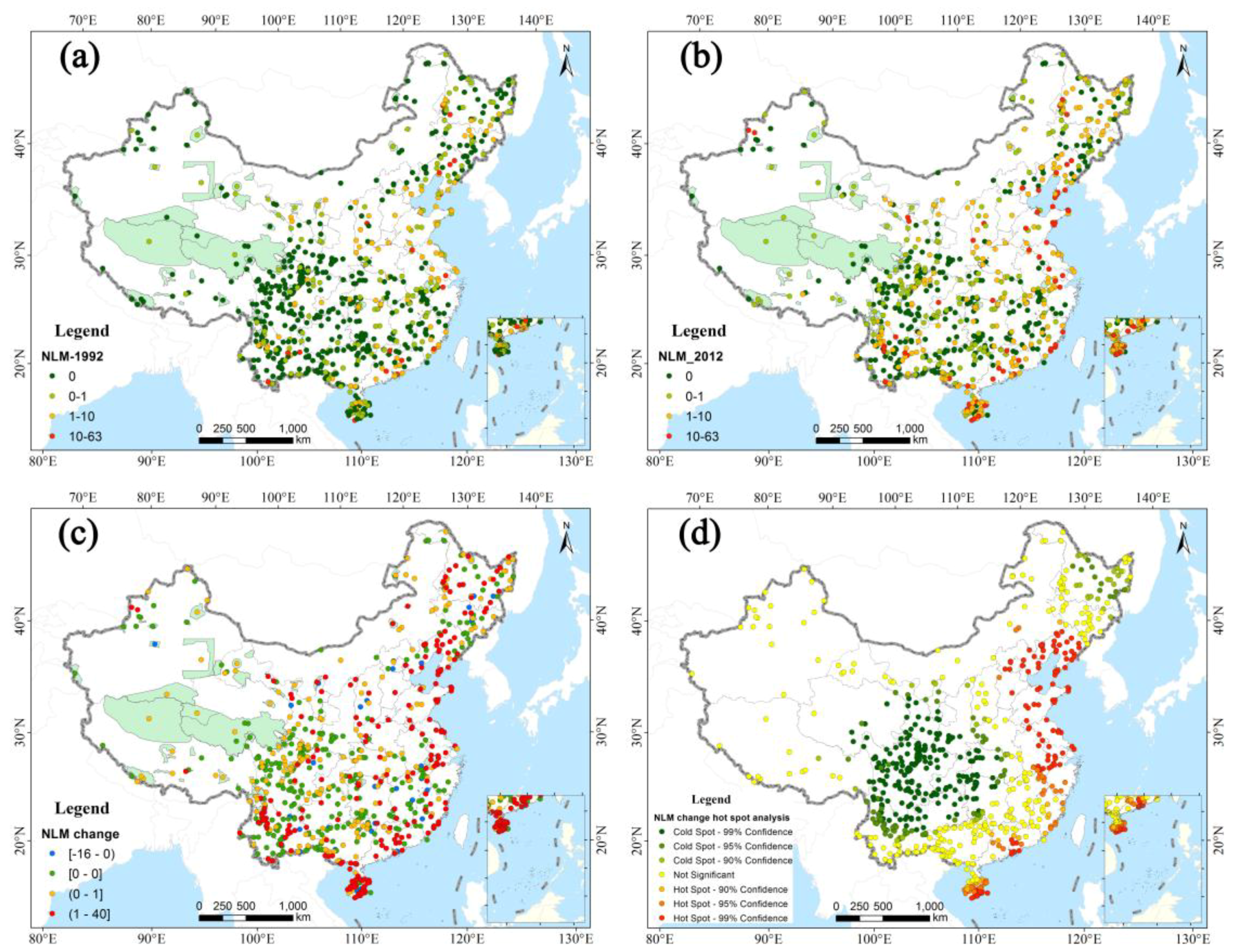
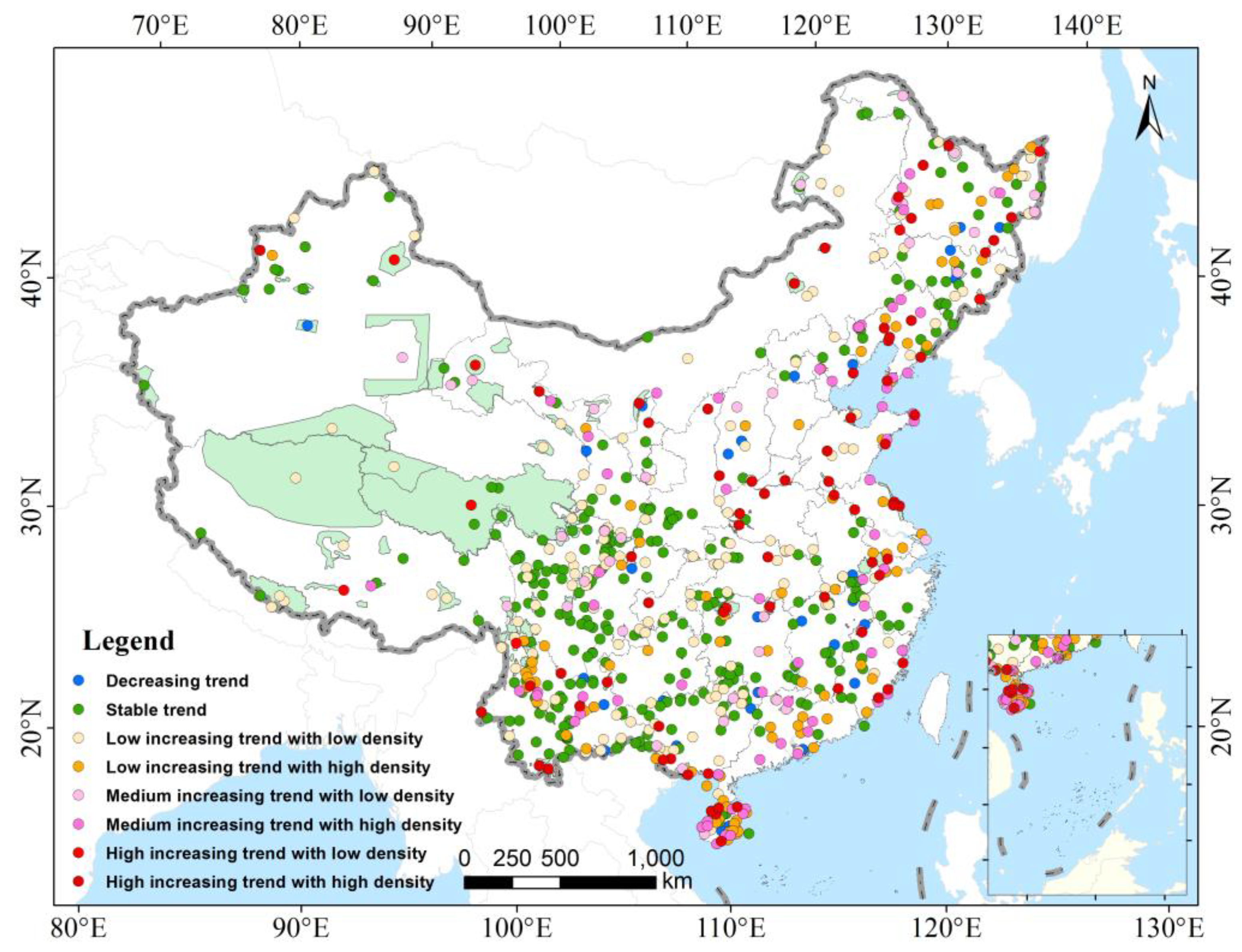
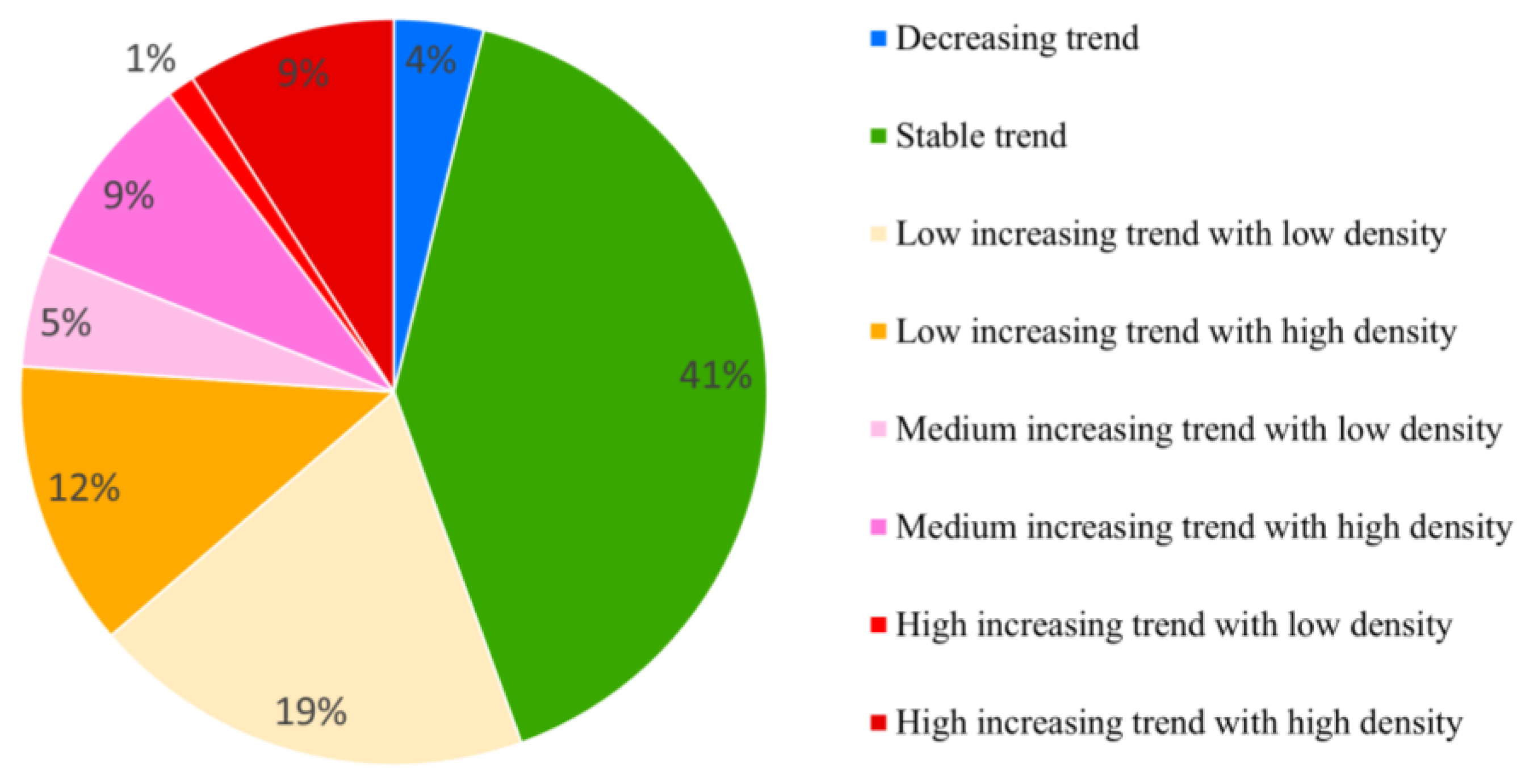
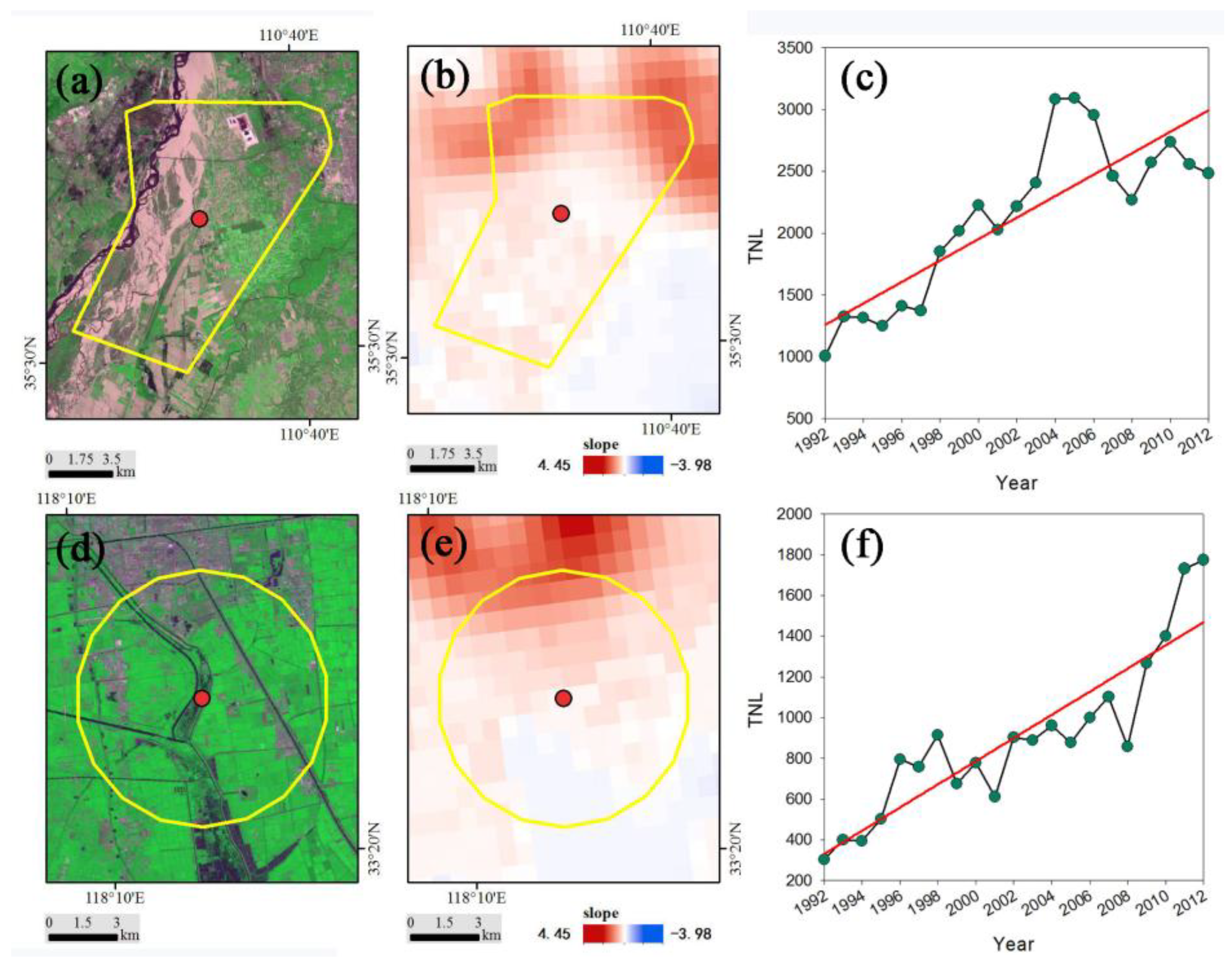
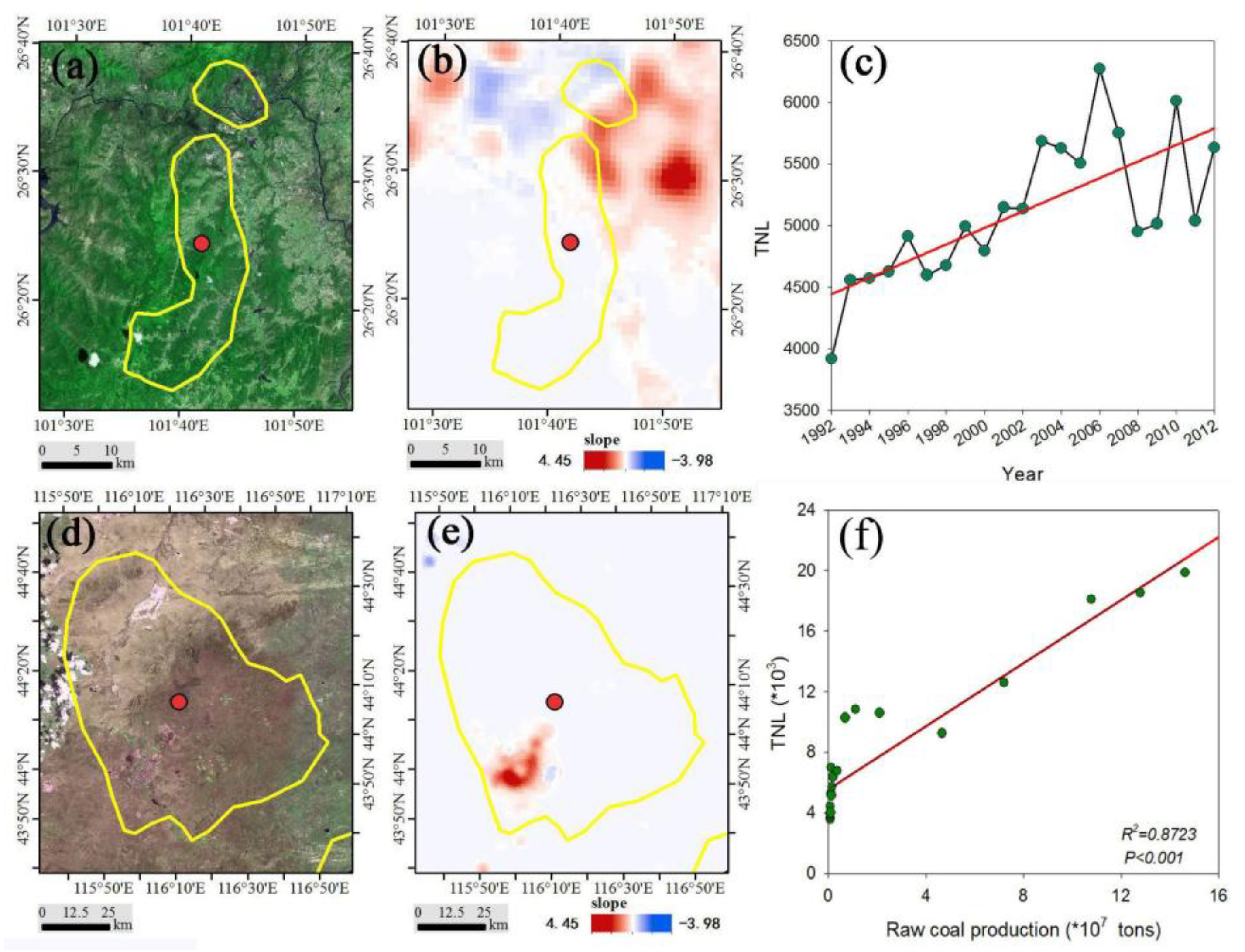
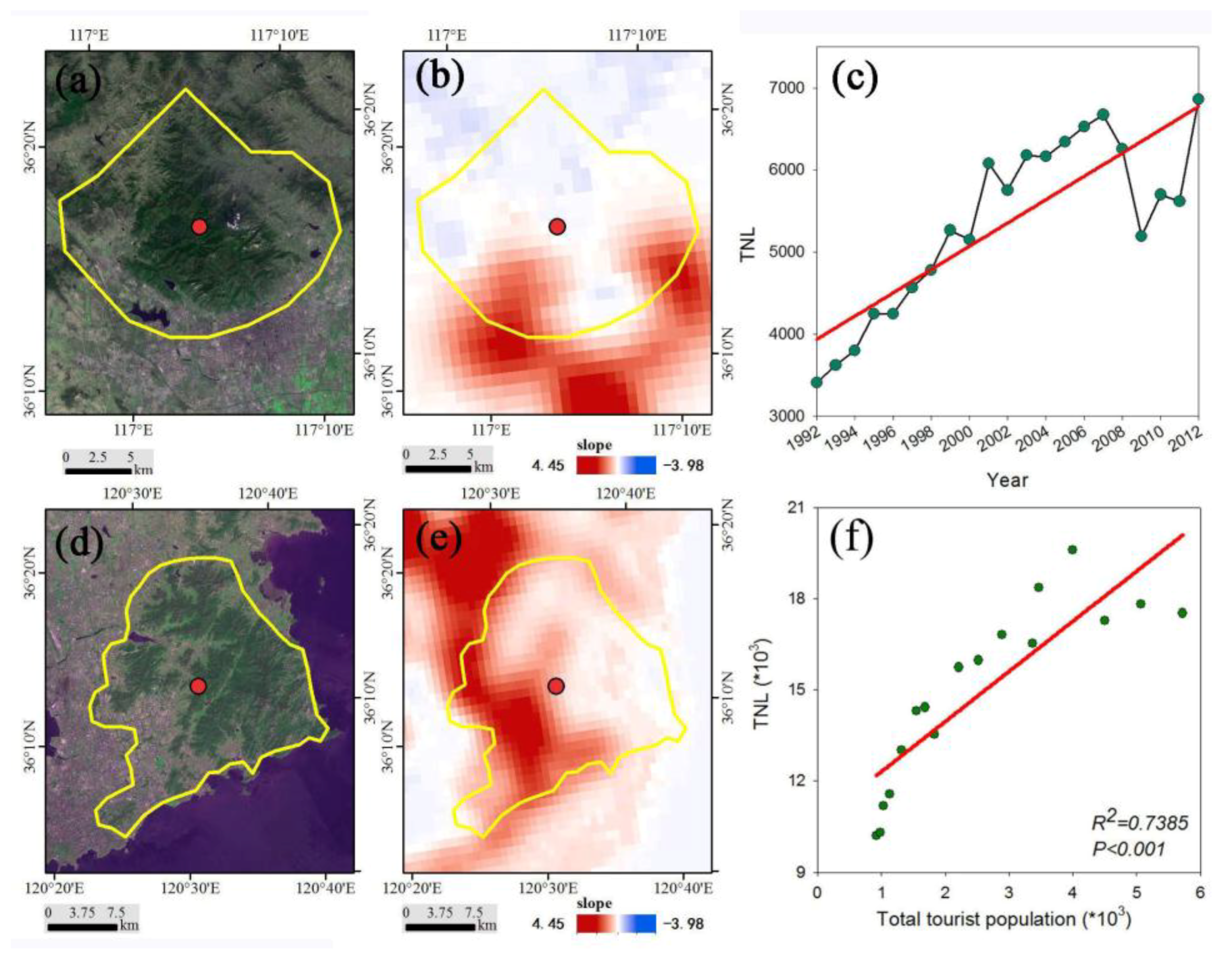

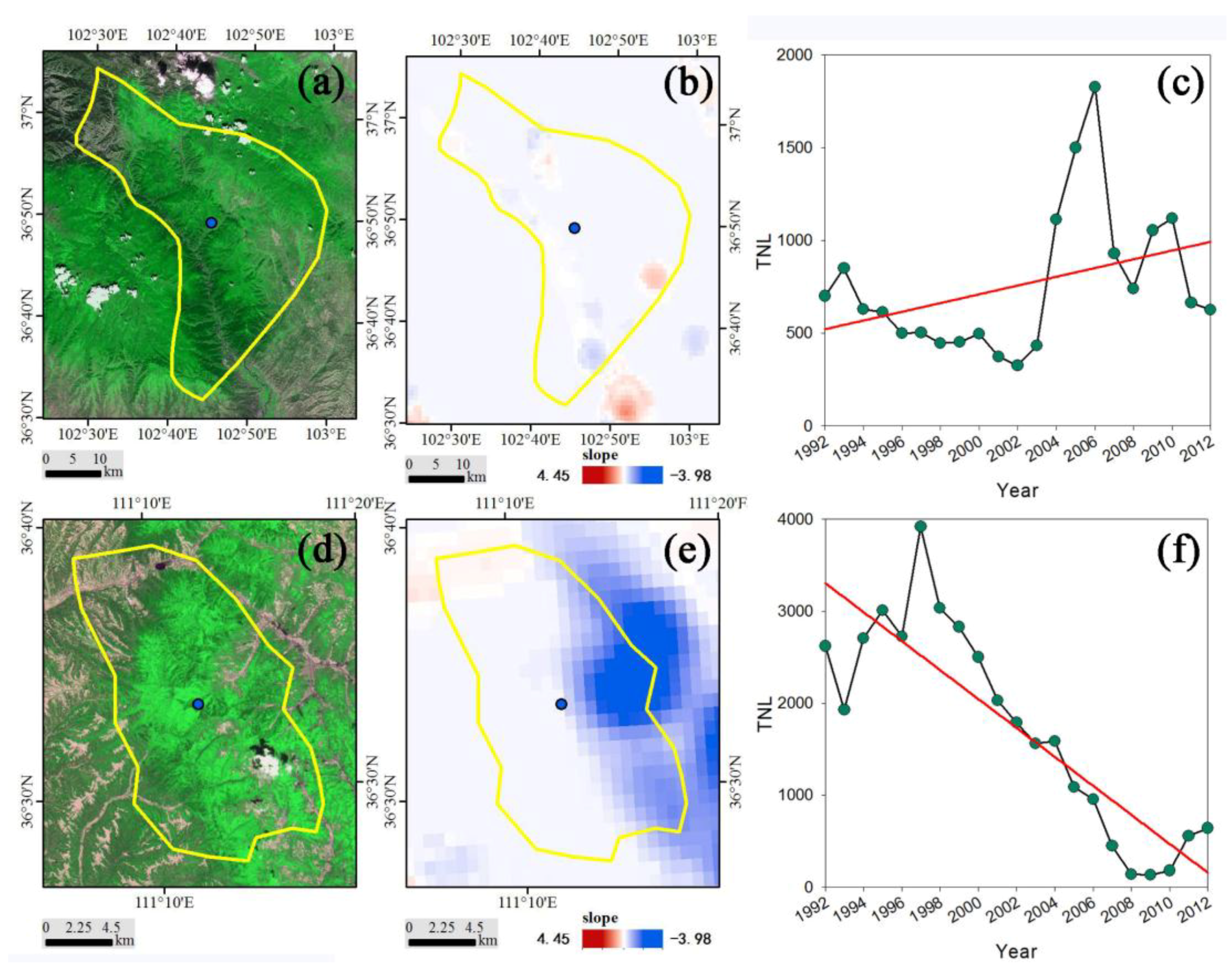
| Class | Criteria | Description | |
|---|---|---|---|
| Class 1 | TNL < 0 | NLM < 0 | Decreasing trend (DT) |
| Class 2 | TNL = 0 | NLM = 0 | Stable trend (ST) |
| Class 3 | 0 < TNL < 300 | 0 < NLM < 1 | Low increasing trend with low density (LL) |
| Class 4 | 1 ≤ NLM < 40 | Low increasing trend with high density (LH) | |
| Class 5 | 300 ≤ TNL < 1000 | 0 < NLM < 1 | Medium increasing trend with low density (ML) |
| Class 6 | 1 ≤ NLM < 40 | Medium increasing trend with high density (MH) | |
| Class 7 | 1000 ≤ TNL <61,000 | 0 < NLM < 1 | High increasing trend with low density (HL) |
| Class 8 | 1 ≤ NLM < 40 | High increasing trend with high density (HH) | |
© 2018 by the authors. Licensee MDPI, Basel, Switzerland. This article is an open access article distributed under the terms and conditions of the Creative Commons Attribution (CC BY) license (http://creativecommons.org/licenses/by/4.0/).
Share and Cite
Jiang, W.; He, G.; Leng, W.; Long, T.; Wang, G.; Liu, H.; Peng, Y.; Yin, R.; Guo, H. Characterizing Light Pollution Trends across Protected Areas in China Using Nighttime Light Remote Sensing Data. ISPRS Int. J. Geo-Inf. 2018, 7, 243. https://doi.org/10.3390/ijgi7070243
Jiang W, He G, Leng W, Long T, Wang G, Liu H, Peng Y, Yin R, Guo H. Characterizing Light Pollution Trends across Protected Areas in China Using Nighttime Light Remote Sensing Data. ISPRS International Journal of Geo-Information. 2018; 7(7):243. https://doi.org/10.3390/ijgi7070243
Chicago/Turabian StyleJiang, Wei, Guojin He, Wanchun Leng, Tengfei Long, Guizhou Wang, Huichan Liu, Yan Peng, Ranyu Yin, and Hongxiang Guo. 2018. "Characterizing Light Pollution Trends across Protected Areas in China Using Nighttime Light Remote Sensing Data" ISPRS International Journal of Geo-Information 7, no. 7: 243. https://doi.org/10.3390/ijgi7070243
APA StyleJiang, W., He, G., Leng, W., Long, T., Wang, G., Liu, H., Peng, Y., Yin, R., & Guo, H. (2018). Characterizing Light Pollution Trends across Protected Areas in China Using Nighttime Light Remote Sensing Data. ISPRS International Journal of Geo-Information, 7(7), 243. https://doi.org/10.3390/ijgi7070243






